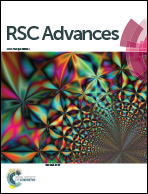Design of core–shell magnetic mesoporous silica hybrids for pH and UV light stimuli-responsive cargo release†
Abstract
This paper reports a controlled drug release strategy through guest diffusion pathways with a “three-in-one” system by combining three advantages together in a single entity. The designed system is composed of superparamagnetic Fe3O4 nanoparticles as the core, a mesoporous silica hybrid as the shell with specific functional moieties, and external trigger (UV-light) responsive functional derivatives as the nanoregulators. The magnetic mesoporous silica hybrid nanospheres (MSH@Azo-CA) were quite responsive to external stimuli such as (i) UV-light and (ii) pH-triggered drug release. The core–shell mesoporous silica hybrid nanospheres were used as a drug carrier for the loading and controlled release of model cargo (e.g. doxorubicin hydrochloride (DOX)/Rh123), because of its combined external (UV-light) and internal (cellular pH) stimuli-responsive behavior and biocompatibility. The experimental study showed that the drug release behavior depends mainly on the UV-light (365 nm)-actuated ‘trans’ conformation and ‘cis’ conformation of the nanoregulators (chrysoidine derivatives) and the intracellular pH of the release medium. The presence of external and internal triggers can result in the good controlled release of loaded cargoes to the target sites. The cytotoxicity of the synthesized core–shell hybrid mesoporous silica nanospheres was examined using MCF-7 cells. The intracellular uptake and release process was observed by confocal laser scanning microscopy (CLSM). In addition, the presence of a magnetic core means that these silica hybrid nanospheres have potential use in the efficient targeted delivery of anticancer agents that can be directed by an external magnetic field for the delivery with a dose predetermined by the ‘ON’ and ‘OFF’ command driven by the external UV-light trigger.


 Please wait while we load your content...
Please wait while we load your content...